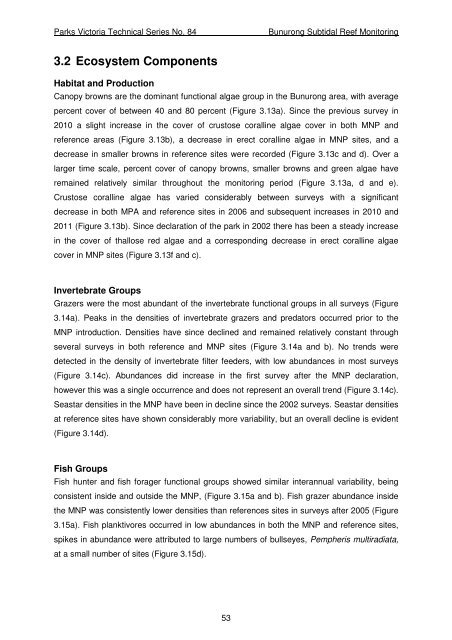the reef biota at bunurong marine national park - Parks Victoria
the reef biota at bunurong marine national park - Parks Victoria
the reef biota at bunurong marine national park - Parks Victoria
Create successful ePaper yourself
Turn your PDF publications into a flip-book with our unique Google optimized e-Paper software.
<strong>Parks</strong> <strong>Victoria</strong> Technical Series No. 84<br />
Bunurong Subtidal Reef Monitoring<br />
3.2 Ecosystem Components<br />
Habit<strong>at</strong> and Production<br />
Canopy browns are <strong>the</strong> dominant functional algae group in <strong>the</strong> Bunurong area, with average<br />
percent cover of between 40 and 80 percent (Figure 3.13a). Since <strong>the</strong> previous survey in<br />
2010 a slight increase in <strong>the</strong> cover of crustose coralline algae cover in both MNP and<br />
reference areas (Figure 3.13b), a decrease in erect coralline algae in MNP sites, and a<br />
decrease in smaller browns in reference sites were recorded (Figure 3.13c and d). Over a<br />
larger time scale, percent cover of canopy browns, smaller browns and green algae have<br />
remained rel<strong>at</strong>ively similar throughout <strong>the</strong> monitoring period (Figure 3.13a, d and e).<br />
Crustose coralline algae has varied considerably between surveys with a significant<br />
decrease in both MPA and reference sites in 2006 and subsequent increases in 2010 and<br />
2011 (Figure 3.13b). Since declar<strong>at</strong>ion of <strong>the</strong> <strong>park</strong> in 2002 <strong>the</strong>re has been a steady increase<br />
in <strong>the</strong> cover of thallose red algae and a corresponding decrease in erect coralline algae<br />
cover in MNP sites (Figure 3.13f and c).<br />
Invertebr<strong>at</strong>e Groups<br />
Grazers were <strong>the</strong> most abundant of <strong>the</strong> invertebr<strong>at</strong>e functional groups in all surveys (Figure<br />
3.14a). Peaks in <strong>the</strong> densities of invertebr<strong>at</strong>e grazers and pred<strong>at</strong>ors occurred prior to <strong>the</strong><br />
MNP introduction. Densities have since declined and remained rel<strong>at</strong>ively constant through<br />
several surveys in both reference and MNP sites (Figure 3.14a and b). No trends were<br />
detected in <strong>the</strong> density of invertebr<strong>at</strong>e filter feeders, with low abundances in most surveys<br />
(Figure 3.14c). Abundances did increase in <strong>the</strong> first survey after <strong>the</strong> MNP declar<strong>at</strong>ion,<br />
however this was a single occurrence and does not represent an overall trend (Figure 3.14c).<br />
Seastar densities in <strong>the</strong> MNP have been in decline since <strong>the</strong> 2002 surveys. Seastar densities<br />
<strong>at</strong> reference sites have shown considerably more variability, but an overall decline is evident<br />
(Figure 3.14d).<br />
Fish Groups<br />
Fish hunter and fish forager functional groups showed similar interannual variability, being<br />
consistent inside and outside <strong>the</strong> MNP, (Figure 3.15a and b). Fish grazer abundance inside<br />
<strong>the</strong> MNP was consistently lower densities than references sites in surveys after 2005 (Figure<br />
3.15a). Fish planktivores occurred in low abundances in both <strong>the</strong> MNP and reference sites,<br />
spikes in abundance were <strong>at</strong>tributed to large numbers of bullseyes, Pempheris multiradi<strong>at</strong>a,<br />
<strong>at</strong> a small number of sites (Figure 3.15d).<br />
53

















